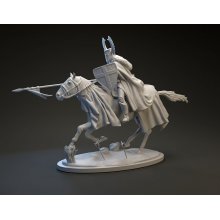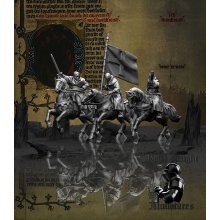This kit includes:
- 2 bodies (with/without helmet)
- 1 horse
- 1 lance
- All models are supplied both Pre-Supported and Unsupported in 28mm scale STLs and LYS files.
During the Prussian Crusade, Hermann von Salza emerged as a pivotal figure: as the Grand Master of the Teutonic Order from 1210 to 1239, Salza navigated medieval politics, forging alliances with both secular and ecclesiastical powers to further the Order's goals.
Christian of Oliva, the first missionary bishop to Prussia, sought assistance from the Teutonic Order against the Prussians in 1226, with the approval of Duke Conrad of Masovia. Although Salza was intrigued by the Polish offer, his primary focus was aiding Emperor Frederick II with the Fifth Crusade to Jerusalem. After meeting Frederick II at Rimini, Salza emphasized the importance of subduing the Prussians to safeguard the Holy Roman Empire's borders. With the Emperor's approval in the Golden Bull of Rimini, the Teutonic Order received Culmerland and any future conquests. The Order's autonomy in territorial acquisitions was reinforced by the Treaty of Kruszwica in 1230, despite disputes over its legitimacy. Subsequently, the Teutonic Knights embarked on campaigns against the Prussian tribes, establishing fortresses and consolidating their control over the region.
In 1230, Hermann von Salza, Grand Master of the Teutonic Order, dispatched Conrad von Landsberg with a small force to Masovia to establish a foothold in Culmerland. They seized Vogelsang Castle and began raids against pagans along the Vistula River. The Order focused on building fortresses along the Vistula, aided by Polish, German, and Pomeranian crusaders. They campaigned against neighboring tribes, including the Pomesanians and the Pogesanians, establishing control and founding new settlements. Despite disputes over territorial claims, the Teutonic Knights continued their campaigns, assimilating other military orders and securing papal approval for their conquests. With support from Henry III, Margrave of Meissen, they expanded their control over Natangia and Bartia. In 1243, Pope Innocent IV divided Prussia into dioceses, formalizing the Order's territorial gains.













